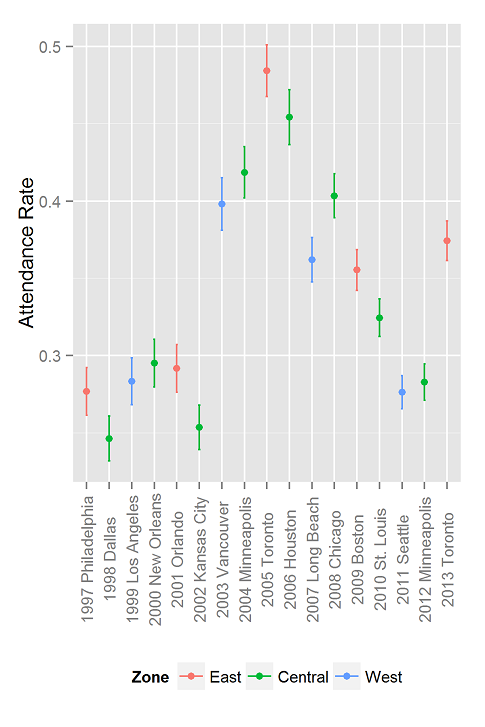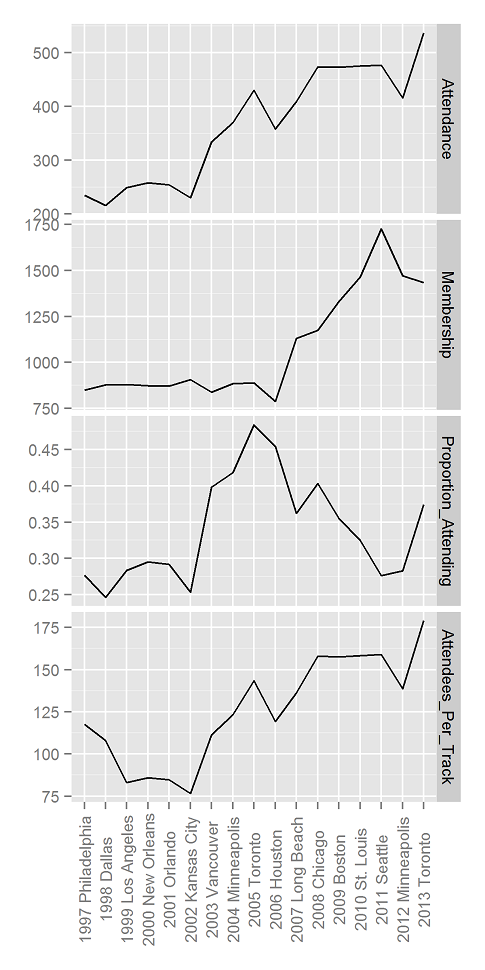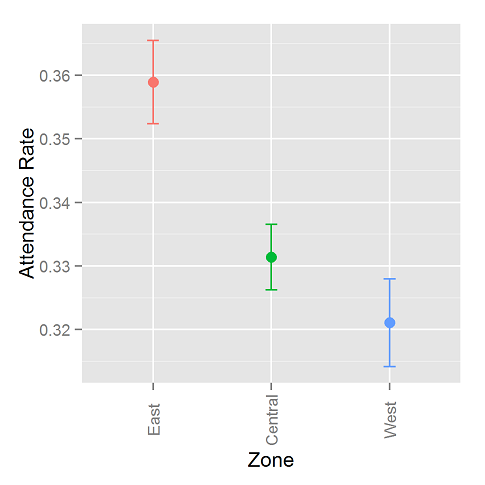What makes a good academic conference?
 Subscribe to Decision Science News by Email (one email per week, easy unsubscribe)
Subscribe to Decision Science News by Email (one email per week, easy unsubscribe)
WHAT WE LOOK FOR WHEN WE DECIDE
We have attended hundreds of academic conferences over the years.
We’ve seen all kinds of formats.
We’ve heard many opinions about what’s good and bad.
Here’s what we look for in an academic conference.
- Small – Fewer than 400 attendees is ideal. At large conferences, people get overwhelmed, retreat into their cliques and tend not to meet anyone new. At smaller conferences, people get to know the other attendees. After attending a small conference for a few years, you get to know a substantial proportion of the attendees. Of course, our choosing to attend small conferences only makes them bigger, but we can’t be bothered to think that many steps ahead.
- Few parallel sessions – We look for conferences that have at most 3 parallel sessions. If you sit in the back of the room at a big conference and look on, you’ll notice that people spend amazing amount of time looking through the program trying to decide what to go to next. Big conferences suffer from the cable TV problem: 57 channels and nothing on. With three tracks of quality content, people will spend less time choosing and will tend to choose well even if they choose arbitrarily (like following the person you were talking to at the coffee break).
- Selective – Selectivity predicts quality. Life’s too short to sit through bad talks. We find that conferences with acceptance rates under 30% tend to be better. Organizers should use poster sessions to enable people to come even if their presentations are not accepted.
- Short talks – With short talks, those who are interested in the research can always get more info later, and those who aren’t interested in the research don’t have to suffer. We like the 20-20-3 model: 20-minute talks (at maximum), 20 talks per track (at maximum), and three tracks (at maximum).
- Plenary and Presidential addresses take priority – If deciding whether to accept more talks or have more plenary / presidential addresses, go for the later. The big talks often have the big ideas, and give all the attendees a common experience to talk about during the conference. Having fewer talk slots will increase the average quality of the talks you do accept and will help keep the conference small.
- No presentations during meals – We don’t talk when others have the stage, but we understand why other people do. Conference are rare opportunities to connect with far-away friends and collaborators. It’s kind of cruel not to let people catch up during meals. Presidents deserve a separate session to get their ideas across. They should not have to compete with the clanking of forks and people talking. In banquet halls, half the audience can’t see the speaker anyway.
- Better yet, more meals on your own – Letting people choose where they eat keeps conference costs down and allows each attendee to spend according to his or her preferences. It’s also nice to see more of a city than just a convention hotel.
- Avoid social events that people can’t walk out of – H/T Eric Johnson. Attendees face a lot of constraints. Some are dead tired from international travel. Others need to juggle catching up with family and various groups of people in the city. The social event shouldn’t keep the attendees captive.
- Centrality – Keep in mind that the location of the conference matters when people decide to submit. Don’t forget the Europeans.
Those are our preferences. We’re open for suggestions!
By the way, registration is now open for the 2014 SJDM conference, which will be held November 21-24 in Long Beach. Early-registration (through Nov. 10) is $225 for members, $260for non-members, and $100 for students. Information on the conference can be found at www.sjdm.org — to register, visit www.sjdm.org/join.html.
Our favorite conference, the Society for Judgment and Decision Making (SJDM) Conference, is coming up soon. Our other favorite conference Behavioral Decision in Research Management (BDRM), just went down splendidly in London over the summer. We often hear people say that the SJDM and BDRM conferences are better than other psychology, decision science, consumer behavior, marketing, policy, and behavioral economics conferences. Perhaps this is due to homophily–SJDM is our favorite conference and we tend to hang out with similar others. But perhaps it is due to characteristics. We don’t have data for BDRM, but we can talk about the JDM conference. Here’s what we observe.
- JDM is small – We have put together some data on JDM attendance over the years (below). Until last year, the conference had fewer than 500 attendees. Pretty sure BDRM has always been similarly small. The Membership panel shows the number of people in the society. Attendance picked up ahead of membership in 2003. Perhaps this has something to do with Kahneman’s Nobel Prize in 2002? Correlation is not causation. We simply remember that around 2005, every grad student in Marketing started saying that they were “doing JDM”.
- JDM has few parallel sessions – We went from two tracks to three in 1999. I will fight to keep it that way.
- JDM is selective – JDM routinely has acceptance rates of less than 30%, despite being a rather specialized and self-selected group of researchers. It also tends to favor people who were not accepted in the previous year. And it has a limit on the number of submissions on which someone can list themselves as a presenter. This keeps people from dominating the program.
- JDM has short talks – 20 minutes is the norm.
- JDM usually has separate Presidential and Plenary talks – Dan Ariely’s talk was the first we remember in which the President didn’t have to compete with a meal.
- JDM has meals on your own – This makes JDM an incredible value for the money. Over the last 5 years, full price registration was $200 on average, and student registration was $98! (Exclamation, not factorial.)
- JDM social events tend to be those people can walk out of – And they tend to be pretty simple. Music, dancing, drinks, done.
- JDM and location – Because JDM follows the Psychonomics Conference around, it tends to be located in major hubs that are easy to get to. The decision as to whether to break with Psychonomics comes up from time to time, but we always decide to stay. I think it’s a good move. It gives attendees the chance to attend the decision-making sessions at Psychonomics, and it saves the society the decision-making costs of figuring out where to have the conference. Yep, real decision experts consider the decision costs. Psychonomics has a policy of moving like a pendulum across the USA: East, Central, West, Central, East, …. The location does seem to affect attendance. See below and the graph at the top of this post. We think that the high attendance in Canada was because it was easier for many Europeans to get to. The estimated changes in probabilities of attending aren’t that great, so it’s probably not too bad to keep following Psychonomics around.
TO DO YOU OWN ANALYSES IN R




